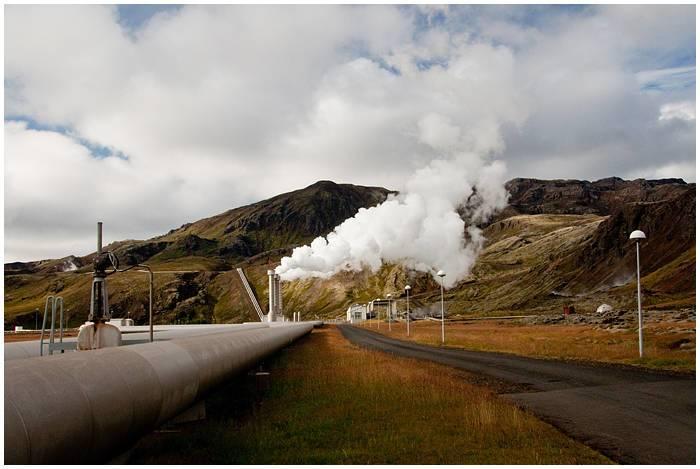Geothermal Energy: Pros and Cons


The core of the Earth, some 4,000 miles beneath its surface, is a fiery morass of superheated gas and molten rock which exists at roughly 7200 degrees Fahrenheit. That temperature is maintained by the decay of radioactive particles located within the Earth’s core. Technically, one could say that geothermal power is a form of nuclear power, though with far different implications from nuclear power as we know it, since these reactions occur in a containment vessel with walls thousands of miles thick. Even so, we still get things like uranium and radon gas, seeping up to the surface.
Moving away from the core, the temperature cools down to the point where it might be 1500 degrees, fifty miles down and 3-400 degrees, three to four miles below the surface. Since the Earth is not at all uniform, these results will vary. There will be some places where the crust is thinner than others, which means the hotter temperatures will be closer to the surface. Hot springs, geysers and, of course, volcanoes can often be found in these places. The Earth’s crust varies from roughly 20 to 40 miles thick as measured from the surface. (It is thinner beneath the sea.)
The amount of thermal energy contained in the Earth’s crust is enormous. Experts estimate it at an equivalent of 79 million billion barrels of oil, or roughly 15,000 times more than estimated worldwide oil reserves. And unlike oil, much of that heat is continually replenished. The hydrothermal resource base (found in hot springs, etc.) has been estimated at 100,000 MW or more.
Geothermal resources vary from location to location, but as new technologies emerge that are capable of utilizing lower temperatures, geothermal power will become more widespread. Iceland, already generates more than 25 percent of its energy from geothermal.
A major new project was recently announced in Kenya.
So how do you produce electricity from this abundant source? It actually almost as simple as drilling a hole in the ground, sending water down, having steam come up and running that steam through a turbine. There are of course many nuances. You can see a nice presentation here.
Geothermal power, like solar thermal power, can also be harnessed for low intensity heat at shallower depths, which can be used for space and water heating and cooling.
So what are some of the pros and cons?
Pros
- Almost entirely emission free
- Zero carbon
- The process can scrub out sulfur that might have otherwise been released
- No fuel required (no mining or transportation)
- Not subject to the same fluctuations as solar or wind
- Smallest land footprint of any major power source
- Virtually limitless supply
- Inherently simple and reliable
- Can provide base load or peak power
- Already cost competitive in some areas
- Could be built underground
- Some level of geothermal energy available most places
- New technologies show promise to utilize lower temperatures
- Prime sites are very location-specific
- Prime sites are often far from population centers
- Losses due to long distance transmission of electricity
- Water usage
- Sulfur dioxide and silica emissions
- High construction costs
- Drilling into heated rock is very difficult
- Minimum temperature of 350F+ generally required
- Care must be taken to manage heat and not overuse it
All in all, this is a very positive balance. There is certainly a lot of potential here and one would expect to see a growing number of systems emerging around the world in places where the resource is abundant.
***
What about other energy sources?
- Pros and Cons of Wind Power
- Pros and Cons of Fusion Power
- Pros and Cons of Tar sands oil
- Pros and Cons of Solar Heating and Cooling
- Pros and Cons of Concentrating Solar Power
- Pros and Cons of Solar photovoltaics
- Pros and Cons of Natural Gas
- Pros and Cons of Fuel Cell Energy
- Pros and Cons of Biomass Energy
- Pros and Cons of Combined Heat and Power
- Pros and Cons of Clean Coal
- Pros and Cons of Algae Based Biofuel
- Pros and Cons of Liquid Flouride Thorium Power
- Pros and Cons of Tidal Power
- Pros and Cons of Nuclear Energy
[Image credit: Eyeline-imagery: Flickr Creative Commons]
RP Siegel, PE, is the President of Rain Mountain LLC. He is also the co-author of the eco-thriller Vapor Trails, the first in a series covering the human side of various sustainability issues including energy, food, and water in an exciting and entertaining format. Now available on Kindle.
Follow RP Siegel on Twitter.
The Story Behind the "Wasting Water is Weird" Campaign


Last year's "Wasting Water is Weird" PSA campaign won the hearts of media insiders because it turned a norm -- freely flowing water -- on its head. Water is ubiquitous when a faucet flows freely and wasting often happens in the privacy of a bathroom or kitchen. What's the most impactful way to get the message through to potentially reluctant customers? Laughter.
The campaign garnered an impressive 432 million impressions - not bad, considering the initial investment from Bosch, Kohler, Lowe's, and P&G was only $600,000.
How did these four groups - competitors in some classes - ever manage to join together to produce any kind of public service announcement? Let alone one as risqué as that with creepy Rip as its spokesperson?
The answer comes from Suzanne Shelton, President and CEO of The Shelton Group, the developers of the concept and content. Shelton spoke at Sustainable Brands 2012.
The Shelton Group, a sustainable research and production firm, developed the campaign pro bono while the brands put up the production funds. The partnership began with the problem: water shortages and a lack of awareness about the need to conserve water. The brands involved assumed that consumers were wasting water because they didn't know any better. The project started with the assumption that Americans just need to better understand the vital importance of water conservation.
The Shelton Group did some research and discovered that in many cases people do know that they need to conserve water - but that fact alone didn't change their behavior. As Shelton said, "Shorter showers are not awesome." It takes more than knowledge to change behavior because change can be uncomfortable.
People needed to be pushed out of their comfort zone in order to be moved to act. The Shelton Group proposed a challenging shift in the project goals: rather than focusing on awareness-building, the campaign would focus on behavior change. The path to behavior change involves four steps: move people from automatic behaviors to conscious choices, make the problem visual (visuals are very compelling motivators), make the problem uncomfortable enough to change, and give people a specific simple action.
Twenty-two percent of people are actively engaged in green and sustainable behaviors, and the Shelton Group figured that if they could be made aware that their behaviors were not matching their values, they might have a shot at changing their behavior. But that meant making people a bit uncomfortable. Hence, Rip was born.
Shelton wasn't sure if the brands involved would stick around after they heard about the shifting goals and the new campaign spokesman, a creepy guy. But, in fact, the collaboration encouraged everyone to stay on board.
When brands collaborate, it's possible to take greater creative risks
Because there were multiple brands participating, they were able to share the risk of producing an off-color ad campaign. Says Shelton, "Rip was a risk – suddenly the risk was spread among multiple brands so it was easier to buy in." Rather than creating infighting, the collaboration allowed the groups to share responsibility - and blame - if there was negative feedback.
There were also a number of other lessons learned:
Brands can make a bigger impact together
This campaign generated hundreds of millions of impressions and continues to receive online views, said Shelton. "Just imagine if Lowe's had taken their $100k and tried to make a difference, they would have had a much smaller impact."
Innovative brand integration
The Water is Weird spots didn't draw attention to their sponsors at all - they didn't even include logos. The brands get their chance to engage through the Water is Weird homepage. Rip has his own Facebook page and Twitter feed, which allowed the brands to interact with Rip and make suggestions like water-saving faucets.
Here's a look at one of their spots:
http://youtu.be/-I1oyppakM0
Tidal Power: Pros and Cons


Day and night, the vast waters of the ocean press and recede along the shorelines of Earth’s every continent in accordance to the celestial movements of our planet in relation to the sun and the moon. This tidal movement is particularly pronounced in certain areas, like the Bay of Fundy, for example, where Spring tides can reach a height of 50 feet or more.
Innovators have long recognized the potential to capture great quantities of clean, free energy from these tides that can be used to spin turbines and readily produce electricity. Records of ocean power conversion date back to 900A.D. where the power of tidal movement was used to grind grains. The first modern commercial tidal power was installed off the coast of St. Malo, in Northern France. Installed in 1965, it has been operating continuously since then, producing 240 MW with every tide. This plant operates using a tidal barrage, which is a type of dam that closes off a basin with gates, captures the tidal flow, then releases it back through a turbine. This is still the most common type of tidal plant in use today, though there are two other types: the tidal fences and tidal turbines.
Tidal fences block a channel directing the tidal flow through turbines that are contained within the fence.
Tidal turbines are freestanding machines that can be thought of as underwater wind turbines, spinning as the tidal flow moves past them.
Because these are purely mechanical device, with no boiling fluids or heat transfer required, efficiencies are quite high, generally in the neighborhood of 80%. Unlike solar and wind, the power coming from these systems is quite predictable, though, like those other renewables, it is also not continuous. They only generate power during tidal surges which occur roughly 10 hours per day. The other issue is the ecologically sensitive areas where these turbines are often placed. Their impacts on biodiversity in fragile coastal ecosystems, while not always completely understood, can often be quite harmful. Let’s rack up the pluses and minuses.
Tidal Power Pros and Cons
Pros
- Renewable. Requires no fuel.
- Emission-free
- Reliable, a plant can last 100 years
- High efficiency
- Predictable output
- Could potentially provide a storm surge barrier.
- Environmental impacts are local, not global
- Expensive to build
- Very location specific (only 20 sites identified with high potential)
- Non-continuous, storage or grid-backup required
- Locations are often remote
- Barrages may restrict access to open water
- Can change tidal level of surrounding area
- Impact on fish, marine mammals and birds
- Disrupts regular tidal cycles
- Decreases salinity in tidal basins
- Mud flats (where many birds feed) adversely impacted
- Captures dirt, waste and pollution near the coast
- Reduces kinetic energy in the ocean
As you can see, tidal power can be expected to play a small, yet not insignificant role in the overall renewable energy ensemble. It has been estimated that it could potentially produce 20% of Britain’s electricity. More research is required to understand how best to tap this resource with minimal environmental harm. Cost also remains a barrier at the moment, but that could change, either through product innovation, or through price increases in other sources. The baseline technology is basically the same as what was used in the 60's which suggests that there are opportunities for innovation. Indeed, Rolls-Royce recently announced a 500 kW tidal stream plant, a type of tidal turbine that has become operational at a test facility, 40 meters deep off the cost of Scotland. Deployed last June it had already delivered 100MWh as of October.
***
What about other energy sources?
- Pros and Cons of Wind Power
- Pros and Cons of Fusion Power
- Pros and Cons of Tar sands oil
- Pros and Cons of Solar Heating and Cooling
- Pros and Cons of Concentrating Solar Power
- Pros and Cons of Solar photovoltaics
- Pros and Cons of Natural Gas
- Pros and Cons of Fuel Cell Energy
- Pros and Cons of Biomass Energy
- Pros and Cons of Combined Heat and Power
- Pros and Cons of Clean Coal
- Pros and Cons of Algae Based Biofuel
- Pros and Cons of Liquid Flouride Thorium Power
- Pros and Cons of Tidal Power
- Pros and Cons of Nuclear Energy
[Image credit: rickz: Flickr Creative Commons]
RP Siegel, PE, is the President of Rain Mountain LLC. He is also the co-author of the eco-thriller Vapor Trails, the first in a series covering the human side of various sustainability issues including energy, food, and water in an exciting and entertaining format. Now available on Kindle.
Follow RP Siegel on Twitter.
Whole Foods 365 Everyday Value: The Good, The Bad, and The Questionable


Originally Posted on EcoSalon
By Jessica Marati
For some, Whole Foods is a god-send – a convenient, well-stocked supermarket filled with a trustworthy, if somewhat overpriced, mix of natural and organic foods. For others, Whole Foods is a symbol of capitalism's ills, a cornerstone of the “Industrialized Organic” complex that is contributing to the death of the small farmer.
Most people I know lie somewhere in the middle: they can’t deny the appeal of a one-stop-shop for their healthy yuppie lifestyles, but they’re skeptical of how conscience-friendly a company can be once it’s grown into a publicly traded corporation. In this week’s Behind the Label, we take a look at the good and the bad of Whole Foods, with a particular focus on its in-house 365 Everyday Value® brand.
If you’re a natural foodie on a budget, you’re probably familiar with 365 Everyday Value, which encompasses a range of products from butter to body wash to balsamic vinegar. 365 products tend to be basic in nature and cheaper than their shelf-mates. But how trust-worthy are they?
The Good
Whole Foods had a humble start as a small natural foods store in Austin, Texas, started by 25-year-old college drop-out (and current CEO) John Mackey, his then-girlfriend Rene Lawson, and a staff of 19. Today, Whole Foods is a publicly-traded company with more than 310 stores in the U.S. and United Kingdom and plans for aggressive expansion in secondary markets over the next decade.
In addition to stocking a wide variety of organic, natural, and locally-sourced foods, Whole Foods also offers a number of generic products under its 365 Everyday Value® brand, which claims to “fill your pantry without emptying your pocketbook.” All 365 products are either certified organic or enrolled in the Non-GMO Project, which verifies that genetically modified organisms are not present in the product. As mentioned in the recent article Behind the Label on Kashi, verification from the Non-GMO Project can be difficult given the preponderance of genetically engineered crops in America, so Whole Foods’ commitment to this issue is worth noting.
Whole Foods has also been a heavy proponent of GMO labeling, a popular topic in the natural foods community.
Our goal at Whole Foods Market is to provide informed consumer choice with regard to genetically engineered ingredients (also known as GMOs or Genetically Modified Organisms). Clearly labeled products enable shoppers who want to avoid foods made with GMOs to do so.
In addition to its stance on GMO transparency, Whole Foods’ quality standards have been recognized as being among the top in the industry, and the company maintains a list of “unacceptable ingredients,” which it says will never appear on its shelves.
The Bad
The 365 Everyday Value® brand's reputation hasn’t always been so squeaky clean. In 2008, a television report from WJLA in Washington, DC, questioned if consumers can trust Whole Foods 365 organic products if the label says that they are made in China. Standards are more lax in China, and the distance these products travels lessens the environmental benefit of choosing organic.
http://youtu.be/JQ31Ljd9T_Y
In a detailed rebuttal to WJLA, Whole Foods' Organic Certification Coordinator Joe Dickson said that products from China can absolutely be certified organic. In the rebuttal, Dickson points out that USDA organic certification measures food integrity regardless of where in the world crops are grown.
Whole Foods Market is a pioneer in promoting and selling natural and organic foods and we have done more in our history as a company to promote and build organics than any other retailer … This is not “selling an image;” this is actually making sure that every one of our 275 stores is operating in compliance with the National Organic Standards and upholding organic integrity in everything they do.
Whole Foods’ assurances have done little to appease foods activists like the Organic Consumers Association, which picketed a Chicago Whole Foods in 2011 for selling genetically modified brands like Tofutti, Kashi, and Boca Burgers.
The Questionable
Whole Foods has taken major strides toward offering organic and GMO-free products at reasonable prices, particularly with its 365 Everyday Value® line. But naturally, the company’s growth and success have earned it many critics, including author and food activist Michael Pollan, who associated Whole Foods with what he calls “Industrialized Organic” in his popular book, The Omnivore’s Dilemma. Whole Foods CEO John Mackey responded to Pollan's claims in an open letter:
I am not sure if merely because of our size and success Whole Foods Market deserves the pejorative label “Big Organic” or “Industrial Organic,” or even to be linked to those categories. I would argue instead that organic agriculture owes much of its growth and success over the past 20 years to Whole Foods Market’s successful growth and commitment to organic. As an organization we continually challenge ourselves to be responsible and ethical tenants of the planet. Through our stores, large and small organic farmers, both local and international, can offer their products to an increasingly educated population that is more interested in organics every day.
Pollan, who professes much respect for Mackey and Whole Foods, responded:
After visiting a great many large organic farms to research my book, many of them your suppliers, it seems to me undeniable that organic agriculture has industrialized over the past few years, and that Whole Foods has played a part in that process–for good and for ill … And as I tried to make clear in my account of the organic industry, much is gained when organic gets big … But surely we can recognize all these important gains without turning a blind eye to the costs: the sacrifice of small farmers and of some of the founding principles of organic farming (its commitment to polyculture, for example; to “whole” rather than highly processed foods; to social and economic sustainability, etc.)
It all seems to trace back to the big corporation/small business dilemma: do you buy your organic kale and locally-harvested honey at the strip mall supermarket, or do you support your local farmers and neighborhood natural foods store? If price wasn't an inhibitor, I'm sure most conscious consumers would go with the second option.
But even on Whole Foods' shelves that conundrum exists. Buy the locally-sourced salad dressing for $13.99, or the generic 365 version for $3.99? The up-and-coming fair trade brand body lotion for $15, or the 365 cream for $5?
While I appreciate the lower-priced options, I can’t help but notice a disconnect. If Whole Foods wants to truly support local farmers and small businesses, the company should stop undercutting their offerings with its lower-priced, mass-produced, 365-branded items.
***
EcoSalon is the web's leading conscious culture and fashion publication for women. Featuring style, design, life and culture, the arts, food, sex and relationships, EcoSalon is the first and finest general interest website for the modern green woman.
SEE ALSO:
Behind the Label: The Kashi Controversy
Behind the Label: McDonald’s See What We’re Made Of Campaign
Behind the Label: Chipotle, Food With Integrity
Check out all Behind the Label columns here.
Image credit: Flickr/Mike Mozart
Liquid Gold: The Economics of Water Trading Markets


Presidio Graduate School’s Macroeconomics course for Spring 2012, is authoring a series of articles. The articles on this “micro-blog” reflect reactions and thoughts on news items, economic theory, and other issues as they pertain to the concept of sustainability. Follow along here.
By Nick Sanderson
Water scarcity is a global reality — nearly half of the world’s population will suffer from severe water shortages by the year 2050 and over $335 billion in investment over the next twenty years is needed to maintain our current drinking water infrastructure.
The distribution of water throughout the world is inefficient and new market tools are being developed to address the issues revolving around water rights and allocation. In the United States, water rights and allocation limits are assigned in a “first-in-time, first-in-right” method where property owners are allowed to withdraw a percentage of water each year because they happen to be “the first ones to spot it.” Critics argue that water right allocation laws do not create any incentives for conservation efforts and some still have clauses built in that require holders to withdraw the maximum amount of water allocated or lose their rights entirely.
An alternative to traditional water tariff scheduling is being developed throughout the world to address these issues of inefficiency and is pricing water relative to supply and demand. The most established market exists today (and has so for over 20 years) in the Murray-Darling Basin in Australia. It is here that the country’s National Water Initiative has created permanent and seasonal water allocations that can be traded through water brokers when amounts are in excess of demand. The price at which it can be traded depends, of course, on the demand for the water and relevant market forces. This model places a more desirable price on water and “punishes” major consumers who cannot take the necessary measures to curb consumption. The efficiency of the water trading market is such that the initial price for water will be equalized throughout the community of consumers, but the marginal price for water during the secondary trade will fall along every consumer's individual demand curve. This will force users to shift resources from low value activities to high value activities and in turn give a more economically viable price to water.
In the United States today, there are a host of water market programs that differ slightly from the Australian precedent, and one in particular, payments for watershed services (PWS), has gained significant traction in protecting valuable watersheds throughout the U.S. but the coordination required to combine the 81 active market-based water management programs throughout the country is difficult.
Ecosystem Marketplace estimates that over $10 trillion in water transfers occur each year impacting 3.24 billion hectares of wetland ecosystems. A new program developed by Ecosystem Marketplace has attempted to coordinate all the existing water trading markets into one dashboard called the Watershed Connect and has been operating for three years now. Additionally, the USDA just announced on May 25th that it will launch the Water Quality Network in September, a program designed to target companies creating impactful water market changes and support them through federal grants.
Sprinklers running in the middle of the day and people hosing down sidewalks will be a figment of the past if true pricing water markets develop throughout the world. If one traces the evolution of energy markets from transaction costs to true costs they can see that the ability to provide clean, reliable sources of energy is dependent upon the reduction in consumption. One reduction method in the case of water is to establish a market for water that can respond to supply and demand and make consumers choose between wasteful practices and conservation.
10 Outstanding CSR Reports


We've partnered with AHA!, a creative communications firm, to deliver this series on CR communications. Throughout the series, we'll explore why your company's CR communications plan should go beyond the CSR report and give you tools to keep communication flowing all year long.
In an earlier post, Christian Hicks, Creative Director of Corporate Responsibility at AHA! listed seven signs he uses to determine if a company has a great CSR report including simplicity, engagement, trustworthiness, and a positive forecast.
Many reports are released every year, and, according to GreenBiz and Ernst & Young, the number is growing. Here are ten reports that impressed our TriplePundit writers. To Hicks’ list, we’ll add our own signs, ranging from innovation to interactivity to arresting visuals to positive, proven results. Not coincidentally, many of the companies that generated these creative accountings are strong CSR leaders themselves, although a few on the list might surprise you.
- Nike. Veteran writer Leon Kaye, who has reviewed several reports on this list, called Nike’s 2011 report, “quite possibly one of the most compelling and engaging I have ever come across.” Although aesthetics couldn’t hide some of the issues Nike admitted to in the pages, like excessive overtime and hazardous chemical management, Kaye ultimately gave this report a big thumbs up for innovation, education, and how it managed to “bring sustainability alive,” using demonstrations and accessible language to engage users.
- Patagonia. It’s no surprise to find Patagonia on this list as the company has long been a CSR trailblazer. Patagonia goes far beyond a simple report to demonstrate its commitment to CSR. This year alone it has stood at the front of the line to register as a B corp, told customers to consume less, and most recently, released The Footprint Chronicles, tracking its product materials from cradle to consumer. Simply putting the name Patagonia on any CSR report is guaranteed to inspire trust, show positive results and look forward to the next groundbreaking goal.
- Seventh Generation. Its 2008 report was named Best Small and Medium-Sized Enterprise SME report by Ceres, and its 2009 report pleased Deborah Fleischer by being entirely web-based and interactive. However, as with Nike, we aren’t fooled by a little fun. Seventh Generation’s reports also deliver solid data on its goals, clear measurement, transparency and the ability to drill down into the details.
- Coca Cola Enterprises. Not to be confused with Coca-Cola, CCE is its European bottling cousin, who, last year, released a CSR report that is not only “chock full of case studies and human interest stories, but it is also full of quantitative data that allows the reader to decide whether the company is making enough impact on the environmental, social, and governance fronts.” Kaye reports that on top of that, CCE released an engaging video that nutshells it all for you. You can learn more about CCE's sustainability work here.
- GE. GE, like Patagonia, has long been known as a green innovator. Its Ecomagination initiative all but eclipses any annual report with its extensive web and social media presence and steady stream of innovative green news all year long. The annual report connects the dots and forecasts what new challenges the company is aiming for in the future. Rather than a single article about GE’s sustainability report, Kaye wrote a series about it’s accomplishments.
- L’Oréal. As you might expect, the cosmetic giant’s report is gorgeous, but once you get past its glossy exterior, the inner data beauty shines through. L’Oréal shows it has technological depth by its focus on plant-based materials, and heart by its development of “artificial skin.” The company has increased production of this reconstructed biological tissue, which it uses to discontinue animal testing. The company has also shared this breakthrough with hospitals to benefit burn victims. Far from superficial, L’Oréal’s report shows real depth.
- Philips. As with L’Oréal, Philips’ CSR report shows stakeholders a whole new side to the company. Literally. The CEO letter begins, “Dear Stakeholder…” Reviewer Raz Godelnik reminds us that although most conjure images of LED lighting when thinking of Philips, there is much more to the company. Green products comprise 39 percent of its total sales, and one of its standout items in 2011 was a recycled designer coffee machine made from old electronic appliances (I’ll bet you didn’t see that one coming). Philips also showed a sensitive social side with their dedication to “oral healthcare, light therapy, water and air purification products and solar-powered lamps.”
- H&M. Fashion and cosmetics are two unlikely CSR candidates, yet, here they are. Although they both face industry challenges to being sustainable, both companies have shown dedication and improvement. Fashion is fraught with consumption and waste, yet H&M’s report went against the grain to impress Kaye, addressing many industry criticisms. Despite being the largest user of organic cotton, the company streamlined its processes to conserve 13.2 million gallons of water. A whopping 71 percent of management positions are held by women, and the company has supported educating Bangladesh workers on their rights and developed an ethical clothing line. Fashion will always have resource consumption issues and room for improvement, but this report shows that H&M has taken some great strides.
- GM. In its first CSR report after the automobile industry shakeup, GM comes off as a phoenix rising from the ashes. This report really needed to inspire trust and have a strong forward vision in order to dispel any lingering ire taxpayers have about bailing out the car company. The fact that Leon Kaye, who often writes about Detroit’s transformation, is giving the report’s claims the benefit of the doubt says something for the persuasiveness of the content. GM’s stated focus on (water) conservation and reducing waste, while slightly ironic, shows that the company is moving in the right direction. GM’s commitment to give back to Detroit, a community struggling due to the auto industry’s mismanagement, also helps its sincerity efforts.
- SAP. RP Siegel had high expectations for the information titan’s annual sustainability report, and he was not disappointed. “One would expect their annual sustainability report to be a highly readable and information-rich document, which is exactly what it is.” In keeping with its transition from physical installation to cloud computing, its report has morphed from PDF to interactive, web-based format. SAP goes beyond describing their own conservation efforts and demonstrates how their products help other companies achieve their sustainability goals.
We capped our list at ten, but there are many outstanding reports out there. Which ones impressed you?
Image credit: Unsplash
From Diversity to Inclusion to Impact: Our Journey at Campbell


Submitted by Guest Contributor
By Kevin Carter, Director, Diversity & Inclusion, Campbell Soup
Similar to every initiative at Campbell Soup, we reexamined our Diversity and Inclusion (D&I) efforts in 2012. It meant asking ourselves several hard questions but most importantly, "what we believe, what we will do and how we will measure our success?"
I serve as the Director of Diversity & Inclusion. I collaborate with business units on diversity strategy; manage our Business Resource Affinity Networks, or BRANs, and conduct facilitated leading and learning on such topics as Intercultural competence and work style orientation. I have also been acquainting myself with social media through Inclusion Innovates to share Campbell D&I efforts externally to build affinity in the marketplace.
This retrospection was important for Campbell, D&I and all our employees because we seemed stuck in a different era; not yet successful connecting with an increasingly large multicultural marketplace. It had become simply crucial that we acted more like the “iconic” brand we aspire to be and build a robust affinity with new demographic groups.
Hispanic Network de Campbell and Pepperidge Farm (HNdeC), one of the company's eights BRANs, has initiated several efforts towards this purpose, many in partnership with the Campbell Consumer Insights Department, to aid the company in gaining a deeper understanding of the Hispanic consumer, including attitudinal and food-specific perspectives.
What We Believe: Diversity and Inclusion
In addressing these questions, it became clear that the company needed to progress from diversity to inclusion to impact. By accepting this as our journey, we would be consciously declaring that D&I is a continuous improvement process that must result in clear business outcomes that lead to organizational success.
Typically, diversity efforts are measured by an organization's ability to attract, select and retain a mix of people in the workplace relevant to effective operations. Similarly, inclusion efforts are usually measured by whether or not this diverse mix of talent is acknowledged, valued and engaged in pursuit of business goals. We are now clarifying one additional, and vital, component: D&I progress is ultimately measured by an organization's ability to leverage a diverse mixture of talent for business impact in sales, productivity and performance.
What We Will Do: Impact
We will focus on talent management, work climate and networks to delivery business impact.
In talent management, our efforts to attract, recruit and retain diverse talent include such activities as recruiting professionals at conferences organized by the National Black MBA Association (NBMBAA), National Society of Hispanics MBAs (NSHMBA) and National Society of Black Engineers (NSBE). We also partner with our BRANs to attract and develop talent at the company.
For example, Campbell Maxton American Indian Network (MAIN) partners with Robeson Community College to assist high school and associate degree students obtain the skills, competencies and opportunities to work at Campbell’s. Specifically, 28 employees have gained additional skills through RCC’s Advanced Manufacturing and maintenance apprenticeship programs which have allowed them to move into our Maintenance department to replace employees who have retired over the past three years.
 When we shift to work climate, the journey switches from active recruitment to consistent education and empowerment.
When we shift to work climate, the journey switches from active recruitment to consistent education and empowerment.
One of our classes on Inclusive Leadership, for example, provides leaders with the awareness, knowledge and skill readiness to enable individuals and groups to contribute their fullest potential. Valuing Diversity, Practicing Inclusion explores the various diversity challenges that are affecting the business and links them to the organization’s existing diversity initiatives.
We are asking our managers to reflect on some fundamental questions such as: how do my strengths prevent others from exhibiting theirs and what don’t I know about others that could aid our collective success?
Educating Managers about Idea Networks
In learning sessions, these types of questions are “eye openers” because managers reflect on how they may not be valuing the diversity, or the uniqueness, that a direct report brings to a collective task. In a recent session, for instance, many participants were surprised about the homogeneity of their “idea networks.” The concept of “idea networks” is important for our diverse employee base because diverse people generate diverse ideas that lead to innovation.
While classroom education serves a specific purpose, we complement these with networking, relationship-building and experiential learning through our eight BRANs.
BRANs are employee led, company supported, volunteer organizations that assist the company with successfully on-boarding, engaging and developing members representing demographic difference within the organization. These Networks have hosted or sponsored sessions such as the Asian Network of Campbell's (ANC) China 101 workshop and the Bridge Network's Generations program and the Women of Campbell and Pepperidge Farm (WoC) Leadership series.
Our BRANs have also reached outwards to connect with business partners. Campbell’s Administrative Professionals (CAPs) hosted the executive assistants of the World 50 organization to foster relationships to accelerate administrative assistant on the job performance, skills and competencies.
Employee Groups: Building Competence, Generating Affinity
BRANs generate three organizational benefits: connection, competence, and business development.
Specifically, BRANs provide members with opportunities to connect with others to share experiences, best practices and form essential support systems. Similar to other organizations; however, it is a constant challenge to prove the value of BRANs to middle-managers. While leaders typically understand that an organization has to cultivate employee engagement and input, we’ve learned that managers don’t always support employee participation, particularly if they are on tight deadline.

To address this reality, we are continually projecting the value BRANs bring to our organization internally as well as externally. It is proven that successfully initiated employee networks generate insights and often business development opportunities. For example, our African American Network (CAAN) hosted presentations on "Multicultural Marketing to African Americans," that led to a spirited discussion on how to increase sales for a specific product segment. ANC then sponsored an internal cooking competition using Campbell’s Chefs and ingredients where recipes were shared at the 33rd Annual Asian American and Pacific Islander Heritage Festival.
Shifting into High Gear: Testing the Power of Social Media
As I mentioned early, however, diversity and inclusion are an evolutionary journey. So over the next 12 to 36 months, we are going to kick things up a notch by doing some things that are familiar, some others that are evolutionary, as well as some that are revolutionary.
The familiar:
- Funding D&I efforts, such as education and external partnerships,
- Supporting BRAN activities, and
- Developing and retaining diverse talent.
The evolutionary: accelerated embedding of D&I through higher levels of manager commitment and BRANs cross-collaboration to create business results.
The revolutionary: an accelerated use of technology, social media and innovative ideas, matched with a culture of open-mindedness, Intercultural expertise and collaboration to reach our objectives.
For example, the Campbell and Pepperidge Farm chapters of Our Pride Employee Network (OPEN) hosted a booth at the Equality Forum "Out" festival. OPEN handed out a mix of V8 Fusion, Sparkling Fusion, V8 Energy, PF Goldfish, Cookies and Crackers and Swanson Flavor Boost varieties with Recipe cards. Additionally, the Network conducted a survey to acquire demographic data about the LGBT community and its allies regarding attitudes towards Campbell and its products.
Our goal in the social media arena is to “step and breathe” – first make connections, gain insights and then collaborate with company departments on projects that generate business. The possibilities are exciting!
How We Will Measure Success
 As most leaders know, D&I management consists of formal and informal processes, policies and practices built in to effectively manage commonalities and differences among all organizational stakeholders in a manner that delivers value to the organization. It's a mouthful but it's meant to be expansive and a testament to the rich diversity of our organizational talent.
As most leaders know, D&I management consists of formal and informal processes, policies and practices built in to effectively manage commonalities and differences among all organizational stakeholders in a manner that delivers value to the organization. It's a mouthful but it's meant to be expansive and a testament to the rich diversity of our organizational talent.
Evolving from diversity and inclusion to impact, the final all-important rung requires an accelerated effort in benchmarking, educating and networking.
Benchmarking: Diversity and inclusion must be managed against clear benchmarks addressing some of our most important organizational challenges like innovation and human capital, two key challenges for all corporations today. D&I connects the two! A diverse team means many more ideas, different perspectives and a continual cycle of innovation. We want to go beyond compliance. This means leveraging information from Equal Employment and Affirmative Action Programs and Employee Life-Cycle analysis with anecdotal and quantitative date to determine the how, what and why of decisions.
We not only position ourselves to limit liability, cost, turnover and missed opportunities; we also facilitate an inclusive, innovative culture that becomes the standard by which others are measured.
Educating: We want to establish Intercultural expertise as a core competency for leaders so that all employees have the opportunity to achieve their full potential on the job. Challenged to bring D&I education to our plants and to remote employees, we will launch a Diversity E-Learning Course. This training will provide learning insights around inclusive behaviors that promote individual and team productivity. As part of Managing the Campbell Way, our goal is to provide behavioral reflections to managers regarding work climates that improve manager quality.
Connecting: We want to create networks within and outside our company to generate insights, to build affinity and to foster innovation among our team members. Currently, BRANs operate relatively independently. Cross-network interaction and cooperation have not been maximized. Our goal is to increasingly leverage the insights of BRAN members internally to spur innovation and to share their value with an increasingly diverse external marketplace.
Which brings me to measurement: How will we measure the success of the journey from diversity to inclusion to impact?
By measuring the level of diversity (the mix, representation, and varied skills and perspectives of people), the breadth and depth of inclusion (people being respected, engaged, and challenged), and improved business results that we generate for our organization.
That is the Campbell way. That is creating shared value.
***************
Previously:
Nourishing our Planet: 50 Interviews, 5 [Sustainability] Priorities
Nourishing our Consumers: Measuring Success Against a Constantly Moving Target
Nourishing Our Neighbors: Audacious CSR Goals Demand Revolutionary Ideas
About Kevin Carter:
Kevin A. Carter is the Director, Diversity and Inclusion (D&I) for the Campbell Soup Co., founder of Inclusion Innovates and a blogger for Inclusion to Innovation and Building the Expo. With Campbell‘s, his current focus is D&I strategy development; managing the company’s Business Resource Affinity Networks; designing and facilitating D&I leading and learning sessions for organizational units on IDI (intercultural developmental inventory) and LIFO (Life Orientations); D&I HR integration and D&I reputation management. With Inclusion Innovates, his “disruptive inclusion” theory and “inclusion innovation” process reflects his belief that the integration of diversity, Intercultural competence and social media technologies leads to breakthrough innovation and business value.
Kevin is also the co-chair of the Conference Board Diversity Leadership Council and the chair of the Diversity Metrics Workgroup of the Society of Human Resources Management (SHRM) Diversity Standards Taskforce. These committees are developing standards and the "new normal" in the diversity and inclusion field.
Solar Thermal: Pros and Cons - Part 2: Concentrating Solar Power


PS20 Solar Power Tower by Abengoa Solar in Spain. (Photo by Tom Raftery)
The term solar thermal has been used to describe two different types of systems. One is where solar panels are used to collect heat, which is used directly as domestic or process hot water, space heating, or in some cases, air conditioning. This most basic form of solar energy utilization, called solar heating and cooling (SHC), was covered in a previous post.
The other, very different type of solar thermal system involves concentrating solar collectors that focus the sunlight, amplifying its intensity, to achieve very high temperatures that can be converted to steam to drive an otherwise conventional thermal power plant or heat engine. This is generally called concentrating solar power (CSP), which is what we are going to discuss today.
According to the National Renewable Energy Laboratory (NREL), there are three basic types of CSP systems: linear concentrator, dish/engine, and power tower systems.
Linear concentrators are curved panels that reflect and focus the sun’s rays onto a tube that runs the length of the panel. The tube contains a fluid that heats up creating steam which is used to drive a turbine. The two main configurations are the parabolic trough type, where the tube runs along the focal line, and the linear fresnel type, which uses Fresnel lenses to collimate the reflected beam such that one receiver tube can be positioned over several mirrors. This type provides greater mobility in tracking the sun and is also less expensive.
Dish engine systems are generally smaller in scale than linear concentrators, ranging from 3-25 kW. They consist of a circular parabolic disk mirror that track the position of the sun and focus its rays onto a power conversion unit which is located along an axis extending outward from the center of the disk at the appropriate focusing distance, which is based on the curvature of the disk. The power conversion unit consists of a thermal receiver and a heat engine. The thermal receivers absorb the heat reflected from the mirror and transfer it to the heat engine. The heat engine used most commonly is the Stirling engine. Stirling engines, unlike internal combustion engines, are heated externally, and do not require the internal explosions that characterize the engines under the hoods of most cars today. Because they can be heated by any of a number of energy sources, including concentrated solar, they are far cleaner and potentially far cheaper to operate than fossil fuel powered engines. Their biggest drawback is that they are slow to respond to changes, making them unsuitable for vehicular use (except perhaps in a hybrid system where they might be used to recharge a battery).
Finally, there are the perhaps the most impressive and most scalable systems, the power towers. Power towers, also known as point-focus central receiver systems, are similar to dish/engine systems, except there is one central engine surrounded by many dishes that all focus onto it. The heated receiver produces steam, which is then used to power a conventional turbine-generator. Two 10 megawatt projects were successfully demonstrated in the U.S., back in the 90s. Spain has also deployed several units up to 20MW (pictured), the most recent using molten salt for energy storage and transfer. In 2009, eSolar launched a 5MW power tower plant, utilizing 24,000 mirrors. The DOE is currently developing a 200-megawatt molten-salt solar receiver panel for power tower technology. Two very large scale plants are also scheduled for completion next year, in the U.S.: BrightSource energy’s 392MW Ivanpah facility on the California-Nevada border, and SolarReserve’s 110MW Crescent Dunes facility, northwest of Las Vegas.
More are on the way. Saudi Arabia recently announced plans to invest $109 billion in solar power, with an eye towards generating some 41 GW, up to a third of their projected demand for the year 2030. Details are not yet known, but it will almost surely involve power tower facilities.
Unlike solar PV and solar heating and cooling, which both take advantage of the fact that the sun shines everywhere and rely on an inherently distributed model, CSP, clearly adheres to the more traditional centralized utility model, where power is transmitted over long distances from a capital-intensive central utility, where it will be sold to ratepayers.
Concentrating solar power
Pros
- Renewable. No fuels required.
- Non-polluting. Carbon-free except for production and transportation.
- Can serve as a drop-in replacement for conventional fuels to make steam
- Operating costs are low
- Can utilize thermal storage to better match supply with demand
- High efficiency
- Scalable to the 100MW+ level
Cons
- Intermittent
- Low energy density
- Slightly more expensive than solar PV
- Construction/installation costs can be high
- Relatively new technology involved
- Hard to compete against very cheap natural gas
- They require a considerable amount of space
- Some people find them unattractive
- Manufacturing processes often create pollution
- Heavily location dependent
- Will involve significant transmission distances/losses
While expensive, and far from simple, CSP holds the promise of clean energy source that can be produced at scales comparable to coal or nuclear, under the appropriate conditions. While still subject to intermittency, it has been suggested that improved thermal energy storage solutions may hold the key to the long term success of CSP.
***
What about other energy sources?
- Pros and Cons of Wind Power
- Pros and Cons of Fusion Power
- Pros and Cons of Tar sands oil
- Pros and Cons of Solar Heating and Cooling
- Pros and Cons of Concentrating Solar Power
- Pros and Cons of Solar photovoltaics
- Pros and Cons of Natural Gas
- Pros and Cons of Fuel Cell Energy
- Pros and Cons of Biomass Energy
- Pros and Cons of Combined Heat and Power
- Pros and Cons of Clean Coal
- Pros and Cons of Algae Based Biofuel
- Pros and Cons of Liquid Flouride Thorium Power
- Pros and Cons of Tidal Power
- Pros and Cons of Nuclear Energy
[Image credit: Tom Raftery: Flickr Creative Commons]
RP Siegel, PE, is the President of Rain Mountain LLC. He is also the co-author of the eco-thriller Vapor Trails, the first in a series covering the human side of various sustainability issues including energy, food, and water in an exciting and entertaining format. Now available on Kindle.
Follow RP Siegel on Twitter.
Run-Up to SB’12: An Interview with Kevin Whilden of Sustainable Surf


In our latest piece in the run-up to Sustainable Brands 2012, Kevin Whilden answers our questions around the implications of climate change on the world’s oceans and how the business community can help nurture a sustainability social framework to garner widespread change towards a more sustainable culture.
Whilden president & co-founder of Sustainable Surf, a company that works with key players within the surfing industry to dramatically improve the environmental performance of their products and services.
What do you think is the most pressing environmental threat facing our planet today? (And what do you foresee the implications being if these threats are not addressed?)
Kevin Whilden: As a surfer, CO2 emissions directly threaten surfing itself. Ocean acidification and ocean warming will make coral reef ecosystems become extinct by 2050, and so much good surf depends on coral reefs. Also, sea level rise will create a “Permanent High Tide” condition at surf breaks, and any surfers knows that high tide generally swamps out the waves at most breaks.
As a scientist, anthropogenic CO2 emissions are the biggest environmental threat by far, and not just because of climate change affecting society. The biggest impact from human CO2 emissions occurs in the oceans, where ocean acidification is happening at a rate unprecedented in geologic history.
This will harm the base of the food web, because half of the plankton in the ocean form their shells from calcium carbonate that is sensitive to an acidified ocean. Ocean stratification is another impact of rapid global warming and this is one of the likely triggers of most major mass extinctions in geologic history.
What kind of revolutionary action needs to be taken to avoid global climate change devastation?
KW: As a global society, we need to reduce human CO2 emissions and learn how to enhance the biogeochemical systems of the Earth to naturally remove CO2 at a much faster rate. That’s the big picture, and we are quite far from it, although there were many ancient and native cultures that had this skill and the wisdom to use it wisely.
The immediate need for action is to develop a social framework that makes reducing CO2 emissions actually fun. Think about it. Very few people think solving this problem can be enjoyable, and it’s easy to ignore something that isn’t fun or immediately beneficial. Until that changes, it’s going to be hard to fight the special interests that want to prevent action on CO2 emissions.
We started Sustainable Surf to create a social group of surfers that can tackle CO2 emissions head-on while living a fun and healthy lifestyle. The solutions are well known, such as reduced consumption, conservation of natural resources, green business innovation, energy efficiency, and permaculture. Most surfers and surf companies are quite receptive to these solutions because it fits with the lifestyle, and many do them already. Ultimately, we believe that the surfing culture can become a global role model for sustainability. We are working with surf companies, pro surfers, surfing NGOs, academics, students, and surfers themselves to create sustainable solutions throughout surf culture.
How is sustainability key to business success? (What do you see as the cost/benefit of choosing to be a sustainability leader?)
KW: The surf brands that we work with view sustainability as highly desirable, but producing a sustainable product does generally cost more. This is a barrier when margins are tight, but also sales of sustainable products are strong because surf brands are quite good at marketing the story of sustainability. The surf culture naturally accepts it and wants it.
The challenges that we see are helping surf brands understand the full value of sustainability. Most brands could use help with evaluating the business benefits of the sustainability actions they take. For example, we were thrilled to see how much excitement employees of Reef had regarding our Waste to Waves program, which has significant value for employee retention, morale, and inspiration. We are currently working with some brands to develop comprehensive evaluation programs of their sustainability actions.
How can businesses take steps to be more innovative for sustainability?
KW: The big leap that needs to happen is for businesses to become more connected with other stakeholders in sustainability, such as consumers, NGOs, academics, and even government. The communication and feedback between brands and these stakeholders needs to strengthen, since everyone has a role to play in protecting the resources that we love.
Innovative companies can gain a competitive advantage from this if they are good at evaluating how the sustainability market and stakeholders evolve. This will help them create more competitive products and stories that sell them.
What is sustainable consumerism? (And what role do you see brands playing in sustainable consumption, leader or follower?)
KW: This is a great question. The simple answer is “give back more than you take.” History shows this is possible on a societal level. For example, Native Americans would clear small sections of the forest with fire in order to grow food and other useful plants. However this would also greatly enhance the biologic productivity of the forest ecosystem itself.
Both humans and non-humans received an increased benefit. In this modern world, an informed “sustainable consumer” should look for products that create significant societal benefits. Fair trade products are a good example. However consumers have limited power to influence which products create societal benefits. Ultimately, brands themselves need to take the lead in creating an integrated strategy to develop societal benefits as part of normal business. They also need to develop relationships with their consumers that tell this story and engage the consumers in the solutions. Surfing brands have an advantage in this regard because they are so good at lifestyle marketing.
Some good examples of this in the surf community are:
- Hurley’s support of the Ecology Center which trains local citizens on sustainable living
- Reef’s support of Waste to Waves which engages people to recycle styrofoam into new products like surfboards and to reduce the amount of plastic that enters the ocean
- Quiksilver’s support of the QuikScience Challenge which educates students on marine science and community service.
- Volcom’s Give Jeans A Chance which encourages kids to donate their used jeans to then be refurbished and given to people in need.
All of the above programs are great, and they are the first steps toward an integrated strategy for brands to develop benefits for society while also developing private benefits for shareholders.
How can the business community come together to make real, positive change? (And what are the risks or advantages for those who decide to collaborate with competitors to help drive change, rather than try to go it alone?)
KW: Simply put, the brands need to realize the true nature of the threat to what they love, and they need to realize that they are in the leadership role. The employees of surfing brands have a deep connection to the sport, and the people are truly working in a field that they love. This will make it easier for them to work together to solve global problems and create benefits for the common good.
Surfing is threatened by global environmental change more than any other action sport. In my lifetime, coral reef ecosystems could become extinct and sea level rise could swamp out most surf breaks at high tide. If we act, we can help future generations experience the same beautiful, clean waves and healthy ecosystems of our time. Surf brands need to engage on CO2 emissions, since this is the primary threat to surfing. If all of the major companies collaborated on solutions, we could make some real progress on meeting this threat.
What role do brands play in the shift to a sustainable economy?
KW: The economy is a byproduct of the lifestyles with which we all live. Surf brands are powerful lifestyle brands with an inherent connection to sustainability. They have the power to help define and promote sustainable lifestyles, particularly for the youth. That can reshape the economy to some extent if it inspires our future leaders to live a sustainable lifestyle.
Whilden will participate in a panel that will explore the relationships between brands and NGOs and the translation of sustainable business value metrics through the lens of surfing at the Sustainable Brand 2012 Conference June 4-7 in San Diego, CA.
Image credit: Pexels
5 Reasons Why Apple's CSR Strategy Doesn't Work


When a company is “starring” on TriplePundit every couple of weeks it’s usually an indication that either a lot of CSR activity is going on there or that the company has a chronic CSR problem. In the case of Apple it seems unfortunately to be the latter. Last week in a very interesting article on HBR Blog, Prof. Gregory Unruh of Harvard offered the explanation that Apple has a reactive CSR strategy, which he described as the "Little Dutch Boy" Strategy. In other words, Apple bothers to act only when there’s a complaint or protest against the company, hoping like the little Dutch boy that poking its fingers in the holes in a dyke will stem the flow and let the company go back to concentrate on designing and selling great products.
While Prof. Unruh is certainly right about Apple’s reactive strategy, I believe the CSR problems of Apple go beyond its reactive strategy. Looking at the main issues Apple has been struggling with in the last couple of years, I identified 5 main problems that cause Apple to fail time and again when it comes to CSR:
1. Lack of stakeholder engagement strategy – Apple simply doesn’t believe it needs to engage stakeholders, not to mention having an engagement strategy. We can see it every time, from not sharing information with Greenpeace about why Greenpeace got it wrong about the power consumption of Apple’s North Carolina data center to not responding at first to Chinese environmental groups investigating pollution issues in Apple’s supply chain in China. Another example is Apple’s tendency to reply to questions from the media about working conditions issues in its supply chain with a generic reply, such as: “Apple is committed to driving the highest standards of social responsibility throughout our supply base.“
These examples show that Apple is very reluctant to engage with any stakeholder that has a critical point of view of the company. The thing is that in all of these cases Apple had to change course eventually, revealing to everyone the information it didn’t want to share with Greenpeace in the first place, talking with the Chinese organizations and even providing more meaningful information to the media. If Apple will establish a strategic way to engage with stakeholders, just like Gap did successfully couple of years ago, it can save itself a lot of trouble.
2. Lack of triple bottom line thinking – Apple hasn’t really adopted the triple bottom line. For Apple it has usually been about maximizing its profits and addressing environmental and social issues as long as they didn’t make a significant impact on Apple’s income. Now, even when Apple claims to promote one of the other elements of the triple bottom line, like people for example, its practices show that it’s still really about the profits.
Take its supply chain – while Apple has a very progressive code of conduct, it also, as the New York Times reported, allows suppliers only the slimmest of profits, which often results in suppliers trying to cut corners, replacing expensive chemicals with less costly alternatives, or pushing their employees to work faster and longer. As Apple could see in the case of Foxconn, this approach can work for some time, but not for the long run. If Apple will start thinking about people and the planet as seriously as it thinks about profits, it might even find out that in the long run there’s no contradiction between these elements.
3. No CSR leadership or team – Unless you’re a company with a CEO devoted to CSR or an established CSR culture, you can’t really do CSR right without a dedicated CSR team. As Andrew Winston put it: “You need people to ride herd and drive the agenda — to do the cross-cutting analyses such as lifecycle assessments, to track and get a handle on the many diverse and complex issues, to present a unified front to employees and external stakeholders, to question business models and find new, heretical ways to operate and serve customers...the list goes on.”
4. Low level of transparency – While it is providing more information than many of its competitors (Amazon for example), Apple’s transparency is still far from being satisfactory. The company does not release a sustainability report, does not reply to the CDP surveys and, until recently, it also didn’t disclose the name of its suppliers or allow a third party to audit the working conditions in its supply chain. It’s time for Apple to stop being so hush-hush and start being more open about the way it does business.
5. Dated approach - Apple still doesn’t have a holistic approach when it comes to sustainability. You can easily see it on its website where there’s a separate page for environment, dedicated mainly to its footprint and a separate page for supplier responsibility, which is focusing on Apple’s supply chain. The division between social and environmental impacts is really out of date and even oil companies like Chevron now have a CSR page. All Apple has to do is to address its CSR approach just like an iPhone or iPad and remember to update it on regular basis.
Image credit: Unsplash